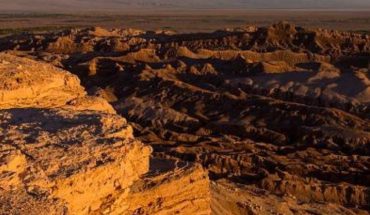Alicia says that in the last communication they had on the phone her husband was heard “happy and nervous at the same time”.
It was the night of Saturday, September 25. Benigno Alberto Álvarez Castro, a 36-year-old Chihuahuan, had been trying to cross for the United States since June. But sometimes because of the bad weather, and sometimes because they still didn’t have the ‘green light’ to ‘jump’, the trip had been postponed for several months.
Benigno was anxious. He had resigned weeks ago from his job in a poultry factory in Chihuahua capital and had already paid his part to the coyote so that he, in turn, would pay “the right of floor” to the organized crime that ‘operates’ the border crossing of Ojinaga. Once on the other side, Benigno planned to first arrive in Arlington, Texas, and from there continue to Oklahoma, where a cousin of his wife was waiting for him to start a business together.
“He looked on Facebook that my cousin was doing very well. And one day they talked and told her to go there, that there was a lot of work and that they put her together,” says Alicia, who asked to protect her true identity for safety.
Read: ‘Omar was not swallowed by the earth, he was taken’: migrant survives the desert, but disappears in Ojinaga
Alicia didn’t think that was a good idea. “It’s a lot of risk,” she tried to persuade her husband. “Better stay and here we see how we do it.” But he was already decided. “I had a lot of plans in my head,” says the woman holding back her tears. He told me that with the money he earned there he was going to pay our eldest daughter for her nursing career, and that the other daughter who is about to turn 15 would have a great party.”
On September 25, at last, everything was ready. The guide who would take them on their journey through the desert had already delivered the money from the crusade to the human trafficker, the coyote, and on Saturday night Benigno called his wife from a safe house, about 80 kilometers from the border between Ojinaga and U.S. soil.
“I’m already in Coyame,” he announced. I have to turn off my cell phone. There is no point in taking it on and wearing a battery because there is no signal in the gap.”
Benigno asked his wife to take care of the three girls and told her not to worry, that as soon as he crossed and had a sign he would mark him back.
“He told us he loved us very much and then turned off his phone. And that was it. We haven’t heard from him anymore,” laments his wife.
Find out: ‘The situation is chaotic’, Church urgently calls on the government to respect the rights of migrants
Alan wanted to come to the U.S. to meet his father.
Benigno Alberto is one of the 13 people who disappeared somewhere in the gap that leads from Coyame del Sotol to the Lomas de Arena community, very close to the Rio Grande that divides Mexico from the United States.
As reported by the Chihuahua Prosecutor’s Office on October 5, a 14-year-old boy who was with the group managed to escape and testified that the migrants were intercepted in the area of the Juárez Valley, in the municipality of Guadalupe that borders that of Ojinaga, by members of organized crime who, armed and hooded, they would have been taken away in three vehicles.
The young man told authorities that he was only told to “go” and that he fled towards the border, where the Border Patrol stopped him and returned him to Ciudad Juarez days later through El Paso.
Most of the missing migrants were from the state of Chihuahua, although it was also reported that there was one person from Queretaro and another from Mexico City. So far, those identified as missing are: Benigno Alberto; Javier Ricardo Lopez Rodriguez, 38; Lorenzo Abraham Gonzalez Mendoza, 39; Emmanuel Aguilar Bailon, 24; Amador Aguilar Mendoza, 55; Jose Luis Pallares, 47; Luis Carlos Islas Villegas, 30; and Alan Ricardo Salas Torres, 22.
Read more: Neither Fox, nor Calderón, nor Peña: AMLO government breaks record of detention of migrants
Marta is the aunt of Alan Ricardo, the 22-year-old. In an interview, the woman explains that Alan was originally from Durango, although he had been living in Juarez for a year. “He liked to spend some time on one side and then go to another. I told him that he lived in ‘hippie mode’,” jokes Marta, who also asks to protect her identity for safety.
Alan, “a restless and cheerful young man,” worked in a maquiladora. But his great motive for crossing into the United States was not economic, but a family one: he wanted to meet his father.
The young man had communicated with his father by video calls and everything was agreed. They would pay a coyote, get to the agreed point, and from there go to Dallas, Texas.
However, Marta says that after leaving Coyame on Saturday 25, the agony began for Alan’s family.
-Where are you son? -wrote his father from United States.
No response.
-Where do you come from?
No response.
On Sunday 26, more messages.
-Son, you already have me worried. Where are you?
No response.
And the next day, the same. Also no response.
“My brother learned of Alan’s disappearance from the media. He spoke to me crying, telling me that he saw on the news in the United States that a group of migrants had disappeared, that they had been taken away by organized crime.”
Read: More than 70,000 migrants were trafficked or kidnapped in Mexico between 2011 and 2020: CNDH report
At that time, the names of the disappeared had not yet been released in Mexico. But Alan’s father already sensed that something serious had happened to him.
“I said, ‘Maybe it’s not true, or it’s others.’ But he was sure he was, because several days had passed and he had not called him,” Marta explains.
Shortly after, on October 5, the Chihuahua Prosecutor’s Office confirmed that fatal intuition: Alan was in the group of 13 disappeared.
Ojinaga, narco domain
More than two months have passed since the event was publicly announced. The Prosecutor’s Office of Chihuahua, in collaboration with other police and military authorities, reported that they are carrying out multiple ground and air tracking tasks daily in the area where the disappearance was reported. But, so far, those searches have not yielded positive results. In fact, Alicia and Marta lament, months later they still do not have a clue that leads to the whereabouts of the 13, or at least to know what happened to them.
“We know that the authorities are working, that they are looking for them,” Alicia concedes. “But it’s already a long time that has been lost in cell phone tracking and gaps in the desert. We think they are not there, that it is a waste of time,” the woman adds.
“What we ask of the Prosecutor’s Office are two things,” Marta says. “One, that now they look for them doing searches in safe houses in all that area of Coyame and Ojinaga, because everyone knows that there are many safe houses there. And another, that they take us with them to the traces.”
Alicia, who left her job to devote herself fully to the search for her husband Benigno, took the initiative to act as a liaison with the authorities. And in an interview he says that they have reiterated to him on several occasions that it is not possible for them to accompany them in the search tasks due to the insecurity that prevails in the area.
“Ojinaga is an area totally dominated by drug traffickers and one of the most violent areas of Chihuahua,” says a Chihuahua activist, who requests anonymity.
“La Línea was left with the trafficking of people at that border point. That is, they no longer want coyotes to pay them a share for the crusade. What they want is to cross them directly to the migrants and keep all the business. That is why the coyotes are also disappearing,” explains the activist, referring to the fact that among the 13 disappeared there is also the guide who took them through the desert, and apparently also the coyote who would have made the agreement with the organized crime group to let them pass.
“There is total control of organized crime; they are the ones who are disappearing people,” says activist Gabino Gómez, a member of the Center for Women’s Human Rights (CEDEHM), who assures that at least 14 other cases of disappeared people in the area have arrived with him, although at different times and individually.
Gomez is accompanying some of the families of the 13 disappeared and also the case of Omar Reyes López, 20, a young man who left his hometown in the state of Hidalgo, who survived seven days walking lost in the desert on the border with the United States, and whose last clue to his whereabouts leads precisely to Ojinaga, where he was also reported missing.
“Omar could not be swallowed by the earth, Omar has someone and we just want him to be returned to us,” said his aunt Sheila Arias in this report published by Animal Político on December 6.
“Don’t look for your relative anymore”
Marta, the aunt of young Alan, says that so far they have only received extortion attempts from people seeking to take advantage of the delicate situation of the relatives of the 13, and false leads.
The last one she received just a couple of nights ago, when a boy contacted her by text message.
“He said, ‘Don’t look for your relative anymore.’ He then apologized to us saying that he had only done his job digging the graves where they had been buried.”
Marta explains that they did believe that it was a reliable clue because even a location with precise coordinates sent them. But when the authorities of the FiscaThey went to search the area and found nothing.
Some of the families tried to conduct searches in Ojinaga, but it has also been in vain.
“It’s very difficult to get in there, because you go in and they immediately start following you,” says Marta. While Alicia exposes that, out of fear, people do not want to talk either.
“To the people who see and hear what’s going on there, I just ask you to tempt your heart, and make an anonymous call,” Alicia asks. “Maybe they think that the walls hear, but they can be locked in a room and give us even a clue from them,” he concludes.
Animal Político sought the Chihuahua Prosecutor’s Office to learn about the progress in the case. In an interview, the district attorney of the northern zone, Jesús Manuel Carrasco Chacón, explained that they are carrying out permanent searches by air and land in four municipalities: Villa Ahumada, Coyame del Sotol, Ojinaga, and Guadalupe.
So far, the prosecutor said that they have several people detained for the “retention they make of migrants and the economic demand they make to their relatives in the United States” and that they have “located alive 60 migrants in the municipalities of Guadalupe and Práxedis Guerrero.”
However, the prosecutor said, none of those people located are part of the group of 13 migrants who disappeared on September 25, so the search and investigations continue.
What we do at Animal Político requires professional journalists, teamwork, dialogue with readers and something very important: independence. You can help us keep going. Be part of the team.
Subscribe to Animal Político, receive benefits and support free journalism.#YoSoyAnimal





